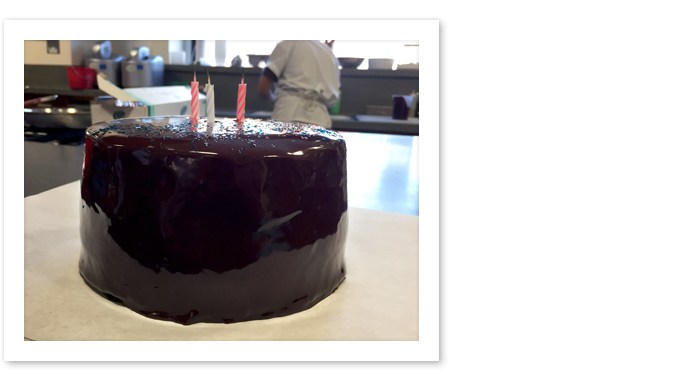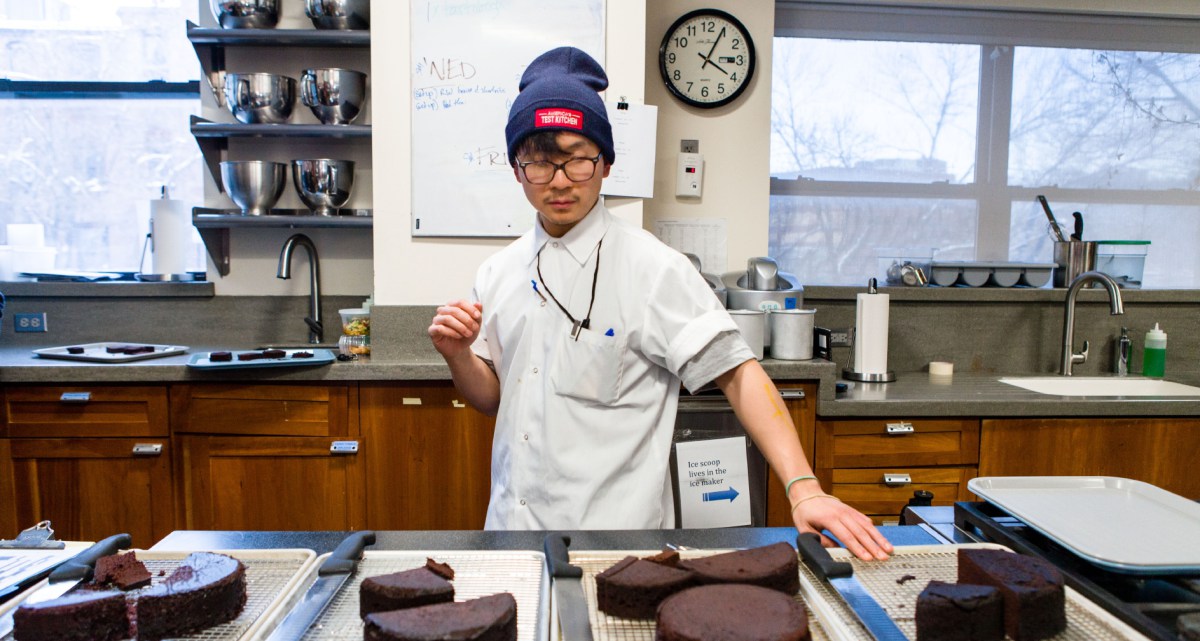In this weekly series, Associate Editor Tim Chin and Test Cook Sasha Marx take you behind the scenes of Cook’s Science and give you a glimpse into our recipe development process, from how we come up with recipe ideas, to test kitchen failures, to discoveries we make along the way. This week, Tim shares his feelings on birthday cake and talks about his latest recipe challenge.
In keeping with the spirit of procrastination that so clearly defines my generation, this week I thought I’d write about my next assignment: developing a birthday cake recipe that goes from mixing bowl to candles-lit in 30 minutes.
First of all, the notion that cake must be presented/consumed on one’s day of birth kind of infuriates me. Do you really need cake on your birthday? Probably not. But you usually get one anyway—whether you want cake or not. In fact, on my last birthday I politely requested a quart of cookies-and-cream ice cream; and naturally, my friends just had to get me an ice cream cake. Birthday cakes are a necessary part of our lives (necessary evil?). But if you think about it—unless you’re buying something pre-made—making a birthday cake is a lot of pressure. First, it has to taste good (and for that, I’m not above using the OG Duncan Hines and Betty Crocker mixes—they’re amazing, versatile, and anyone who says otherwise is straight up bougie) and, second, it’s got to look nice. But there’s also the time investment: Making a nice cake takes effort and time—at least a couple hours to bake, cool, layer, and frost it.
So, I got to thinking: How do you streamline the process? Would it be possible to make a birthday cake in less than an hour?
To me, the obvious answer was the microwave. And before you all start poo-pooing me with ideas about ionizing radiation and mutant broccoli, I’ll tell you this: I’m not your doctor, and I’m not going to tell you how to live your life. The microwave is a tool like any other, and we ought not to demonize its use. It’s a fast way to cook foods and—when used with discretion—an effective way to cook them as well.
Food typically requires heat to cook (or bake). At its essence, heat is the transfer of energy by temperature differences, and on a micro-scale, that transfer is seen as increased motion of molecules; hotter molecules move faster than cooler molecules. Most foods contain a good number of water molecules. Since water molecules are polar (they each contain a positive and negative charge), when they are exposed to the electromagnetic waves (microwaves) emitted by a microwave oven, they try to align with the radiation’s oscillating electric field, and begin to rock back and forth rapidly (up to billions of times per second), creating friction and heat.
What does this mean? You can cook things fast in a microwave, and, instead of cooking from the outside in as in a conventional oven, all the water molecules throughout the food heat up at the same time, inside and out.
Working in kitchens, I’ve only made two types of cakes in a microwave before. First, there are siphon cakes—a technique developed by Albert Adrià years ago and popularized at El Bulli. They are similar to sponge cakes, and used extensively in fine dining as a component of plated desserts. The process is simple: pipe an aerated batter through a siphon into a cup with a tiny ventilation hole in the bottom, then microwave it for a few moments until it’s done. The cake is light, airy, almost like seafoam. But it’s hardly sturdy enough to layer or frost, and would definitely fall apart in a birthday cake application.
The second type is the mug cake. I’ve made more of these than I care to admit. Take a bunch of ingredients, mix them into a large mug, and microwave for a couple minutes. Simple, quick, and dirty. They’re prized for their fudgy texture and their convenience. But these cakes dry out quickly, and they are under-baked on purpose, neither of which are ideal for a birthday cake, plus they, too, lack the structure necessary for layering and frosting.
I needed a cake that can stand up to layering, frosting, glazing, and finally slicing. Sponge cakes and mug cakes are both fragile by design, but—in theory at least—there’s no reason I couldn’t make a classic birthday cake in the microwave. So I looked to a handful of recipes that I knew worked well in the past in an oven, along with one cake recipe actually designed for the microwave. I figured chocolate was a safe option, so I went with chocolate cakes. I mixed the batters, poured them into oven-proof dishes, popped them in the microwave, and prayed.
And believe it or not, they turned out pretty well for a first try.

Overall, the cakes baked up in record time. The longest bake time clocked in at about 16 minutes, while the average bake time hovered around 12 minutes. For reference, a typical cake of this size would take 25 to 35 minutes to fully bake in a traditional oven. Not too shabby. As for the finished textures, all the cakes turned into clean rounds with even, tight crumb structures, though some were moister than others. Two cakes were particularly promising—they had a pleasing, moist texture and boasted solid chocolate flavor. I’m working on synthesizing aspects of our two favorite recipes into a finished product our team likes. And most importantly, figuring out the best technique for cooking the cake in the microwave in terms of timing, cooking vessels, etc. I’m also wondering if I can cut down on the baking time even further, since I’ve only been cooking at 50 percent power.
If I can get the baking time to 10 minutes or less, I might have a shot at coming in under 30 minutes from start to finish. Even then, I’ll still need to find quick ways to chill, layer, frost, and possibly glaze the cake. But I’m hopeful that the cake will work out. Who knows? Maybe I’ll inspire a generation of microwave Cake Bosses.
Do you have any experience with microwave cakes? Any tips for me? Drop a line in the comments. I’d love to hear what you think.
Photography by Kevin White.



